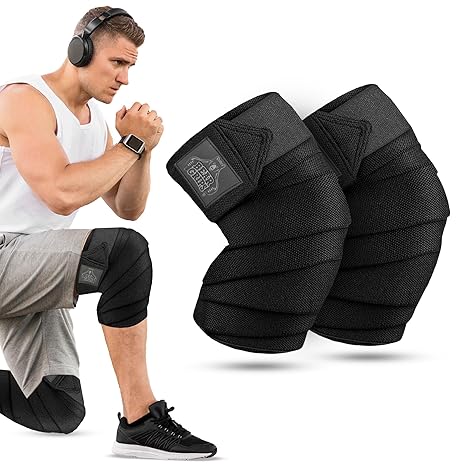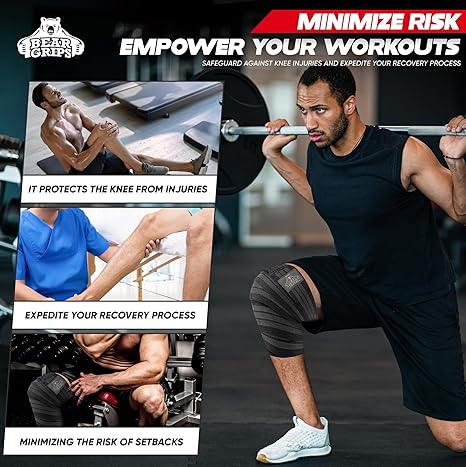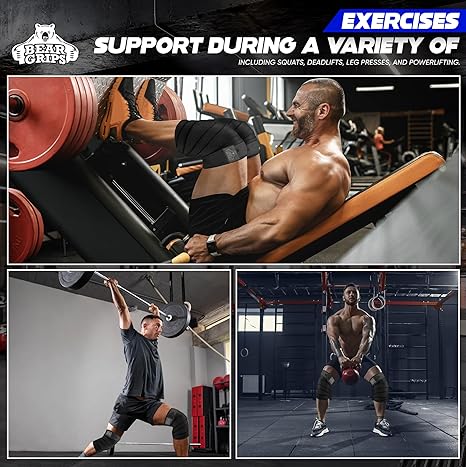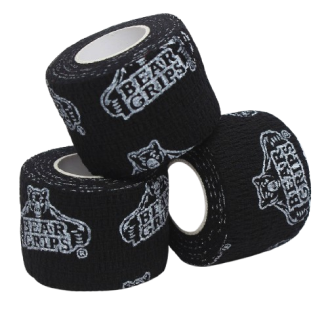
Reasons Why You Need Knee Wraps
Share
Are you looking to amp up your workouts and heavy lifts? Look no further than knee wraps! These handy accessories provide enhanced support, improved performance, and injury prevention during your fitness activities.
When you incorporate knee wraps into your routine, you'll be able to lift more weight, improve your squatting technique, and create energy through the wrap's pressure. Not only that, but knee wraps can also offer relief from knee pain, reduce inflammation, and decrease swelling when used correctly and sparingly.
It's important to note that knee wraps are specifically designed to enhance and support heavy lifting. They may not be beneficial for individuals with poor squat form or pre-existing joint problems. So, if you're looking to take your workouts to the next level, knee wraps are the way to go!
Key Takeaways:
- Knee wraps provide enhanced support, improved performance, and injury prevention during workouts and heavy lifts.
- They allow you to lift more weight, improve squatting technique, and create energy through wrap pressure.
- Knee wraps can offer knee pain relief, reduced inflammation, and decreased swelling when used correctly.
- They are beneficial for individuals who want to lift heavier weight, improve knee safety, and reduce pressure and strain on the quadriceps tendons.
- Knee wraps should be used to enhance and support heavy lifting and may not be suitable for individuals with poor squat form or pre-existing joint problems.
Knee Wraps vs Knee Sleeves: Which is Right for You?
When it comes to choosing between knee wraps and knee sleeves, it's important to consider your specific needs and goals. While both options provide support and assistance, they differ in terms of functionality and versatility.
Knee Wraps
Powerlifters often prefer knee wraps for their ability to maximize weightlifting potential. Knee wraps excel in powerlifting competitions where energy storage and momentum are key. By tightly wrapping around the knees, the wraps create a spring-like effect, increasing stored energy and enhancing performance during heavy lifts.
However, it is important to note that knee wraps can be more restrictive due to the additional material that wraps around the knees. This can limit mobility and potentially impact form and technique if not used correctly.
Knee Sleeves
Knee sleeves, on the other hand, are a popular choice for both heavy lifting and recovery. While they may not offer the same degree of support as knee wraps, knee sleeves provide compression, warmth, and stability to the knees.
Knee sleeves are also highly versatile and can be used in various athletic activities, such as running, basketball, and volleyball. They are particularly favored by CrossFit athletes who require both support and flexibility during their workouts.
Ultimately, the choice between knee wraps and knee sleeves depends on your specific goals and preferences. If you are a powerlifter seeking maximum energy storage and momentum, knee wraps may be the ideal option. If you are involved in a range of athletic activities and prioritize mobility and form, knee sleeves may better suit your needs.
What Are Knee Wraps and When to Use Them?
Knee wraps are compression-type wraps designed to provide support and stability to the knee joints. Made of elastic material, knee wraps are longer in length, typically measuring 72 inches or longer. These wraps are specifically designed to help ease tension and stress on the knees and quadricep muscles, offering added support during intense workouts and heavy lifts.
The primary function of knee wraps is to provide enhanced support to the knee joints, offering stability during exercises that put significant strain on the knees, such as squats, leg presses, deadlifts, and other squat variations. By applying specific tension to the quadriceps muscles, knee wraps help reduce the pressure and strain on the quadriceps tendons, ensuring safe and efficient movement.
When used correctly, knee wraps can offer several benefits, including:
- Allowing individuals to lift heavier weights by providing added support to the knees
- Improving knee safety by reducing stress and strain on the knee joints
- Minimizing the risk of injury to the quadriceps tendons by relieving tension and pressure
- Providing stability and aiding in maintaining proper form during intense exercises
However, it's important to note that knee wraps should not be used as a substitute for proper form and technique. They are best suited for heavy lifts or one-rep maximums, where the added support can help individuals push beyond their limits while minimizing the risk of knee injuries. Over-reliance on knee wraps for every workout may hinder the development of strength and stability in the knee joints, so it's important to use them sparingly.

Here's an example of a table summarizing the benefits of knee wraps:
| Benefits of Knee Wraps | Description |
|---|---|
| Enhanced support | Knee wraps provide added support to the knee joints during intense exercises. |
| Improved stability | By reducing stress and strain on the knee joints, knee wraps help maintain stability and proper form. |
| Reduced pressure on quadriceps tendons | Knee wraps relieve tension and pressure on the quadriceps tendons, minimizing the risk of injury. |
| Increased lifting capacity | The added support from knee wraps allows individuals to lift heavier weights, pushing beyond their limits. |
How to Use Knee Wraps
When it comes to utilizing knee wraps effectively, there are two major techniques that you can employ to maximize their benefits: the spiral technique and the cross technique.
Spiral Technique
In the spiral technique, begin by placing the knee wrap below the knee. Then, wrap it around the leg in a spiral motion until the material runs out. It is crucial to apply the appropriate tension to provide adequate support without constricting the knees. This technique ensures even compression and stability throughout the knee joint.
Cross Technique
The cross technique involves starting the wrap above the knee and criss-crossing it before maneuvering it below the knee. From there, weave the material from the top to the bottom until it runs out. This method allows for targeted compression and support in key areas of the knee, offering enhanced stability and relieving tension.
Most knee wraps on the market feature a convenient Velcro strap that allows for easy securing and adjustment, ensuring a comfortable fit during your workouts or training sessions.
It's important to note that using knee wraps may require some trial and error to achieve the perfect fit and comfort level. Initially, it is recommended to wear them slightly loose to adjust to their feel and optimize performance gradually.

Knee Wraps vs Knee Sleeves: A Comparison
When comparing knee wraps and knee sleeves, there are a few factors to consider. Knee wraps can potentially cause added knee pain and may affect squat form. They provide more support for heavy lifts but are more restrictive. Knee sleeves, on the other hand, keep the knees warm, provide compression, and are suitable for a variety of activities including running and basketball. Knee sleeves offer pain relief and support but do not help lift heavier weight. It's important to note that knee wraps and knee sleeves should not be used as long-term solutions for joint or knee pain.
Knee Wraps
Knee wraps are primarily designed to provide support and stability during heavy lifts. They are made of elastic material that allows for tight wrapping around the knees, offering increased compression and support to the joints and muscles. By providing this added support, knee wraps can help prevent knee pain and injuries during intense weightlifting sessions. However, it's crucial to use knee wraps correctly and sparingly, as over-reliance on them can negatively impact squat form and hinder natural joint movement.
Knee Sleeves
Knee sleeves, on the other hand, are versatile and suitable for a wide range of activities. Made of neoprene or similar materials, knee sleeves provide compression, warmth, and mild support to the knees. They help improve blood circulation, reduce swelling, and alleviate minor knee pain. Knee sleeves are particularly beneficial for activities that involve repetitive knee movements, such as running, jumping, and agility sports. While knee sleeves do not offer the same level of support as knee wraps during heavy lifts, they provide adequate protection and stability for most athletic endeavors.
Here's a comparison table of knee wraps and knee sleeves:
| Knee Wraps | Knee Sleeves | |
|---|---|---|
| Support | Provide excellent support for heavy lifts | Offer moderate support for various activities |
| Compression | High compression for joint stability | Provides mild compression for increased blood flow |
| Injury Prevention | Helps prevent knee injuries during heavy lifting | Reduces knee strain and supports recovery |
| Knee Pain Relief | May potentially cause added knee pain | Provides mild pain relief and reduces swelling |
| Weightlifting | Allows for heavier lifts and energy storage | Does not aid in lifting heavier weight |
| Activity Versatility | Primarily suited for weightlifting | Suitable for running, jumping, and various sports |
Overall, the choice between knee wraps and knee sleeves depends on your specific goals and activities. If you are primarily focused on heavy lifting and maximizing performance, knee wraps may be the better option. However, if you engage in a variety of athletic activities or experience mild knee pain, knee sleeves can offer adequate support and compression. Remember to prioritize proper squat form and technique above lifting heavier weight, and always consult with a healthcare professional or trainer for personalized advice.
In Conclusion
Knee wraps and knee sleeves are essential tools for athletes and fitness enthusiasts looking to enhance support, improve performance, and prevent injuries during intense workouts and heavy lifts. Knee wraps provide the additional support needed to lift heavier weights by allowing for greater energy storage and momentum during lifts. They are particularly favored by powerlifters who rely on maximal strength and explosiveness to excel in their sport.
On the other hand, knee sleeves offer compression, warmth, and support for various athletic activities, making them popular among CrossFit athletes and individuals engaged in activities like running, basketball, and volleyball. They provide the necessary stability and prevent injuries by keeping the knees warm and providing gentle compression to support the joints.
When choosing between knee wraps and knee sleeves, it's important to consider personal goals and preferences. Knee wraps are ideal for individuals seeking to push their limits and lift heavier weights, while knee sleeves are versatile and suitable for a range of activities. Regardless of the choice, proper squat form and technique should always take precedence over the desire to lift heavier weights. It is crucial to use knee wraps and knee sleeves correctly and sparingly to prevent over-reliance on the added support.
Remember, knee wraps and knee sleeves are valuable tools, but they should not be used as long-term solutions for joint or knee pain. Consult with a healthcare professional or trainer for personalized advice and appropriate usage. By prioritizing proper squat form, understanding individual needs, and utilizing knee wraps and knee sleeves wisely, athletes can optimize their performance and minimize the risk of injury.
Find durable knee wraps for gym sessions at Bear Grips right now!
Shop Now at Amazon.com.
FAQ
What are some reasons why I would need knee wraps?
Knee wraps provide enhanced support, improved performance, and injury prevention during workouts and heavy lifts. They help you lift more weight, improve squatting technique, and create energy through wrap pressure. Knee wraps can also offer knee pain relief, reduced inflammation, and decreased swelling, when used correctly and sparingly.
What is the difference between knee wraps and knee sleeves?
Knee wraps are preferred by powerlifters because they help store more energy and allow for greater momentum during lifts. They are more restrictive due to the extra material that wraps around the knees. Knee sleeves, on the other hand, are great for heavy lifting and recovery and are popular among CrossFit athletes and individuals involved in various athletic activities. Knee sleeves provide compression and warmth, but they are not a replacement for mobility and form.
What are knee wraps and when should I use them?
Knee wraps are compression-type wraps designed to provide support and stability to the knee joints. They are made of elastic material and are commonly used during exercises such as squats, leg press, deadlifts, and other squat variations. Knee wraps are beneficial for individuals who want to lift heavier weight, improve knee safety, and reduce pressure and strain on the quadriceps tendons. It's important to limit their use to heavy lifts or one-rep maximums to prevent over-reliance on the added support.
How do I use knee wraps?
There are two major ways to apply knee wraps. The first is the spiral technique, where the wrap is started below the knee and wrapped in a spiral motion until the material runs out. The tension should be enough to provide support without constricting the knees. The second option is the cross technique, where the wrap is criss-crossed starting above the knee and maneuvered below the knee. The material is then weaved from the top of the knee to the bottom until it runs out. Most knee wraps feature a Velcro strap for easy securing. It may take some time to perfect the fit and comfort of knee wraps, so wearing them slightly loose initially is recommended.
What are the differences between knee wraps and knee sleeves?
Knee wraps can potentially cause added knee pain and may affect squat form due to their restrictive nature. They provide more support for heavy lifts. On the other hand, knee sleeves keep the knees warm, provide compression, and are suitable for a variety of activities including running and basketball. Knee sleeves offer pain relief and support but do not help lift heavier weight. It's important to note that knee wraps and knee sleeves should not be used as long-term solutions for joint or knee pain.
How do knee wraps and knee sleeves enhance support, performance, and injury prevention?
Knee wraps provide additional support, allowing for greater energy storage and momentum during lifts. They enhance performance and help prevent injuries during heavy lifts. Knee sleeves offer compression, warmth, and support during various athletic activities, improving overall performance and reducing the risk of injury. Both options have their advantages and should be chosen based on individual goals and preferences. Proper squat form and technique should always be prioritized above lifting heavier weight.


